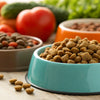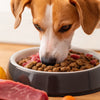How Much Kibble for a 30 lb Dog: A Comprehensive Feeding Guide
- Houndsy
Table of Contents
- Introduction
- Understanding Your Dog’s Nutritional Needs
- The Houndsy Kibble Dispenser: Elevating the Feeding Experience
- Feeding Frequency: How Often Should You Feed Your Dog?
- The Importance of Quality Kibble
- Common Feeding Mistakes to Avoid
- Conclusion
Introduction
Did you know that nearly 59% of dogs in the United States are considered overweight or obese? This startling statistic highlights the importance of understanding proper dog nutrition, particularly when it comes to feeding our furry friends. As pet parents, we all want our dogs to live healthy, happy lives, and one of the simplest yet most crucial ways to achieve this is by ensuring we provide them with the right amount of food.
In this blog post, we will delve into the question, "how much kibble for a 30 lb dog?" By the end of our discussion, you will have a thorough understanding of the various factors that influence your dog's dietary needs, practical guidelines for portion control, and how to make informed decisions about your dog’s nutrition. We’ll also showcase how our flagship product, the Houndsy Kibble Dispenser, can simplify and elevate your dog-feeding experience.
We invite you to reflect on your current feeding routine and consider how it aligns with the best practices we’ll discuss. Let’s embark on this journey toward better nutrition for our beloved pets.
Understanding Your Dog’s Nutritional Needs
Factors Influencing Food Portions
When it comes to determining how much kibble to feed your dog, several critical factors come into play. Understanding these factors will help you provide a balanced diet tailored to your dog's specific needs.
1. Age
Age is a significant determinant of how much food your dog requires. Puppies need more calories and nutrients compared to adult dogs because they are growing and developing. In contrast, senior dogs may require fewer calories due to decreased activity levels. For example, a puppy may need up to three meals a day, whereas an adult dog typically thrives on two meals per day.
2. Activity Level
The more active your dog is, the more calories they will need. Dogs that engage in regular exercise, such as running or playing fetch, will require larger portions compared to those that are more sedentary. It’s essential to adjust their food intake based on their daily activity level to maintain a healthy weight.
3. Body Condition Score
Assessing your dog’s body condition score (BCS) is an excellent way to determine if they are at a healthy weight. This scoring system evaluates your dog's overall physique, helping you decide if they need to gain or lose weight. If your dog is overweight, you may need to reduce their food intake, whereas underweight dogs may require more.
4. Health Status
Your dog’s health can significantly influence their dietary needs. Dogs with specific medical conditions may require specialized diets. Always consult your veterinarian if you have concerns about your dog’s weight or health.
Calculating Portion Sizes
Now that we understand the key factors influencing feeding, let’s discuss how to calculate the appropriate amount of kibble for a 30 lb dog.
1. General Guidelines
Most dog food brands provide feeding guidelines based on weight. For a 30 lb dog, typical recommendations suggest feeding anywhere from 1.75 to 2.5 cups of dry kibble daily, depending on the caloric density of the food. For instance, if your kibble contains 350 calories per cup, you may need to adjust portions accordingly.
2. Utilizing Feeding Charts
Feeding charts from your dog food packaging serve as a great starting point. They typically outline the daily amount of food based on a dog’s weight. For a 30 lb dog, you would refer to the section labeled for 20-40 lb dogs and find the recommended daily amount.
3. Dividing Meals
If feeding twice a day, divide the daily portion by two. For example, if you determine your dog needs 2 cups of kibble daily, you would feed 1 cup in the morning and 1 cup in the evening.
The Houndsy Kibble Dispenser: Elevating the Feeding Experience
As we emphasize the importance of proper feeding, we want to introduce a solution that aligns with our mission of simplifying and enhancing the dog-feeding experience: the Houndsy Kibble Dispenser.
Key Features
- Convenient Design: Our dispenser features a crank at standing height, eliminating the need for bending, making it easier for you to serve your dog.
- Perfect Portions: With the Houndsy Kibble Dispenser, you can ensure consistent portion control every time, reducing the risk of overfeeding.
- Stylish Aesthetics: Designed with mid-century modern style, it complements your home decor while providing functionality.
- High-Quality Materials: Our dispenser is built with durability in mind, featuring a BPA-free liner to keep kibble fresh and safe for your pet.
- Large Capacity: With a storage capacity of 25-30 lbs, you can stock up on your dog’s favorite kibble without frequent refills.
- Auto-Locking Mechanism: This feature prevents accidental dispensing by curious pets or toddlers, ensuring your dog gets the right amount of food.
To explore how the Houndsy Kibble Dispenser can transform your feeding routine, check it out here.
Feeding Frequency: How Often Should You Feed Your Dog?
Feeding frequency is another critical aspect to consider. Most veterinarians recommend feeding adult dogs twice a day, while puppies may require three to four meals. Let’s break this down further:
1. Puppies
- Puppies up to 4 months old need to be fed three to four times a day to support their rapid growth.
- Between 4 to 6 months, you can start transitioning to three meals a day.
- By the time they reach 6 months, you can generally reduce feeding to twice a day.
2. Adult Dogs
- Adult dogs typically do well on two meals a day, which helps maintain their energy levels throughout the day.
- For some dogs, especially larger breeds, splitting their daily kibble into three meals may be beneficial to prevent bloating.
3. Senior Dogs
- Senior dogs may also benefit from two meals a day, but monitoring their weight and adjusting meal sizes accordingly is essential. Some may require smaller portions due to decreased activity levels.
The Importance of Quality Kibble
Choosing high-quality kibble is imperative for your dog’s health. Premium dog foods often contain real meat, whole grains, and vegetables, providing essential nutrients. Here are a few tips for selecting the right kibble:
1. Read the Ingredients
Look for a kibble that lists meat as the first ingredient. Avoid foods that contain fillers or artificial preservatives.
2. Check Caloric Density
High-quality kibble is often more calorie-dense, meaning you might need to feed less compared to lower-quality options. Always refer to the feeding guidelines on the packaging.
3. Consult with Your Vet
Your veterinarian can provide personalized recommendations based on your dog’s weight, age, and health status, ensuring that you choose the best food for your furry friend.
Common Feeding Mistakes to Avoid
Even with the best intentions, feeding mistakes can happen. Here are some common pitfalls to avoid as a conscientious pet parent:
1. Overfeeding
Overfeeding is a common mistake that can lead to obesity and health issues. Always measure your dog’s kibble accurately and adjust as necessary based on their weight and activity level.
2. Ignoring Body Condition
Many pet owners overlook their dog’s body condition score. Regularly assess your dog’s physique to ensure they are at a healthy weight.
3. Inconsistent Feeding Schedule
Dogs thrive on routine. Feeding them at the same time each day helps regulate their digestion and keeps their energy levels stable.
4. Neglecting to Consult a Vet
If you notice sudden changes in your dog’s appetite or weight, consult with your veterinarian promptly. They can help identify any underlying health issues.
Conclusion
Feeding our dogs the right amount of kibble is essential for their health and well-being. For a 30 lb dog, understanding the factors that influence their dietary needs—such as age, activity level, and body condition—is vital for providing optimal nutrition. By utilizing feeding charts and measuring portions carefully, we can help prevent issues like obesity and nutritional deficiencies.
At Houndsy, we believe that the feeding experience should be both functional and beautiful. Our Houndsy Kibble Dispenser is designed to enhance your daily routine while ensuring your dog gets the right portion every time. To explore how our dispenser can transform your feeding experience, check it out here.
As you reflect on your pet feeding practices, consider what adjustments you can make to improve your dog's diet and overall health. Remember, a happy dog is a healthy dog!
FAQ
How much kibble should I feed my 30 lb dog?
For a 30 lb dog, the typical recommendation is between 1.75 to 2.5 cups of kibble per day, depending on the caloric density of the food.
How often should I feed my dog?
Most adult dogs should be fed twice a day, while puppies may require three to four meals until they are mature.
What factors affect how much food I should give my dog?
Factors include age, activity level, body condition score, and overall health status.
Can I adjust the amount of food based on my dog's activity level?
Absolutely! If your dog is more active, they may require more food, whereas less active dogs may need smaller portions.
What should I look for in quality dog food?
Choose kibble that lists meat as the first ingredient, avoids fillers, and meets AAFCO standards for nutritional adequacy.
Is overfeeding common among dog owners?
Yes, overfeeding is a common mistake that can lead to obesity and associated health risks. Always measure portions carefully.
How can the Houndsy Kibble Dispenser help with feeding?
The Houndsy Kibble Dispenser allows for precise portion control, is ergonomically designed for convenience, and enhances your home decor.
By following these guidelines and utilizing tools like the Houndsy Kibble Dispenser, we can ensure our dogs lead healthy, fulfilling lives.













